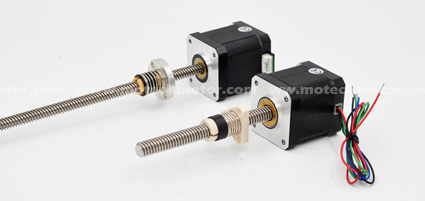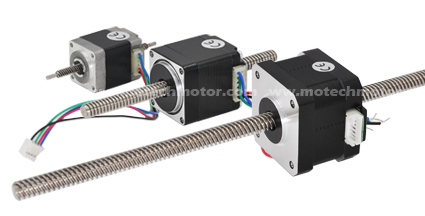
A linear stepper
motor is an electric motor that converts an electrical pulse signal into linear
motion. It converts rotational motion into linear motion through the
interaction of pulsed electromagnetic fields generated by the magnetic rotor
core and stator. Linear stepper motors can directly perform linear motion or
linear reciprocating motion without the need for external mechanical linkage
devices, thereby simplifying the design and improving motion accuracy.

To choose the
appropriate model, please pay attention to the following points:
1. Load requirements
Determine the
appropriate motor size based on the required load, such as Nema 8, 11, 14, 17,
23.
Loads are divided
into static loads and dynamic loads. Static load refers to the maximum thrust
that the screw bears when it is stationary, and dynamic load refers to the
maximum thrust that the screw bears when it is moving. When selecting, both
factors should be considered simultaneously.
2. Running speed
Select the
appropriate lead screw based on the required linear running speed of the motor,
such as Tr8 * 2, lead screw outer diameter=8mm, and lead=2mm.
The running speed of
a linear motor is closely related to the lead of the screw, which refers to the
displacement distance of the nut on the screw axis when the screw rotates one circle.
The larger the lead, the greater the displacement of the nut per turn of the
screw, and the faster the movement speed. Generally speaking, when the speed is
high, choose a large lead; When the speed is low, choose a smaller lead.
3. Movement distance
Determine the
appropriate length of the lead screw based on the required linear running
distance.
The length of a
screw includes two concepts: full length and thread length. The full length
refers to the overall length of the screw, and the thread length refers to the
total length of the threaded part.
4. Nut type
There are many types
of nuts, and when selecting, the installation size and the performance
requirements should be considered comprehensively. For example, the flange
form, length, material, and type (standard/anti-backlash nut) of the nut.

5. Usage environment and special requirements
Consider the
requirements of special applications, such as waterproof, oil-resistant, etc.
If necessary, please communicate further with our sales engineer.

In our product series,
we also offer non-captive linear motors in addition to providing external nut
linear motors.
The working
principle of the non-captive linear motor is to integrate the nut with the
motor rotor into one, and the screw shaft passes through the center of the
motor rotor. When in use, fix the screw and prevent it from rotating, when the
motor is powered on and the rotor rotates, the motor will move in a straight
line along the screw; Conversely, if the motor is fixed and the screw is prevented
from rotating, the lead screw will move in a straight line.